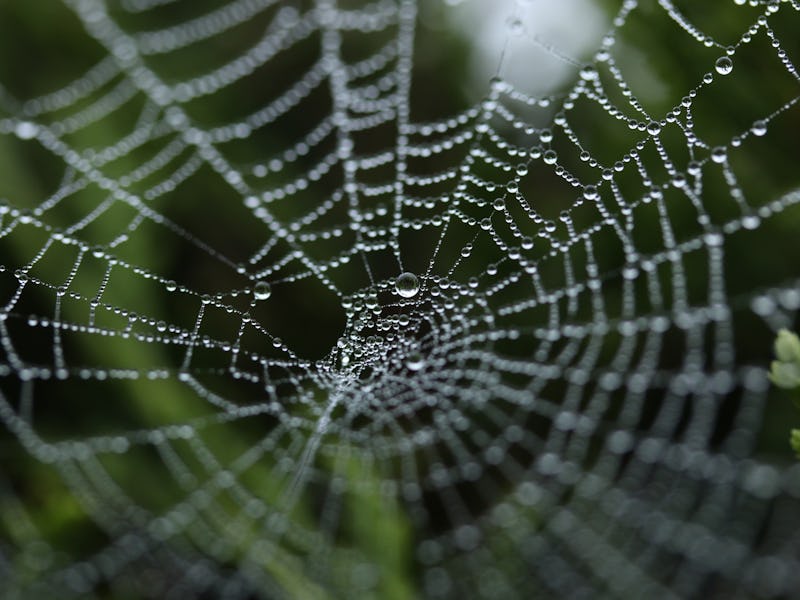Intense Hurricanes Are Making "Super Abundant" Spiders More Aggressive
"Combine hurricane increases with global warming and I think you could get something like that."

In the most uncomfortable piece of climate crisis-related news yet, a team of scientists believe that the increasing tropical cyclones may be changing the temperament of a “super abundant” spider. As the storms continue to increase in tandem with the planet’s temperature, some of our eight-legged friends are starting to get more aggressive, report scientists in a paper published Monday in Nature Ecology and Evolution.
Specifically, these findings refer to a species of group-dwelling spiders called Anelosimus studiosus. They’re “hardly majestic,” lead study author Jonathan Pruitt, Ph.D., an associate professor at the University of California Santa Barbara, tells Inverse, but they happen to have very intricate social lives. Along the Gulf Coast, the spiders form multi-female groups that hunt in packs, dwell in group webs, and sometimes rear each other’s children. But the climate crisis may be shifting these old spider traditions toward a less interconnected lifestyle.
"Combine hurricane increases with global warming and I think you could get something like that."
In the paper, Pruitt and his team show that hurricanes are actually changing the social and behavior dynamics of these spider colonies. The aggressive spiders in the colonies are well-equipped to handle the chaos, but the less aggressive ones are not. That inequality, he explains, may reshape life in the colony.
“There’s a behavioral tipping point when very very aggressive colonies stop working together, start killing each other, and the group wisely disbands,” he says. “Combine hurricane increases with global warming and I think you could get something like that.”
Anelosimus studiosus, a social cobweb spider, can live in groups, but if the group becomes too aggressive it can disband.
The species as a whole will fare just fine, he says, in case you’re worried about losing even more animal and insect species to climate change. But the spiders are a good example of the way incomprehensibly large events — say, increases in large storms — can cause minute but significant changes too, like the behavior of a five-millimeter-long spider.
How Storms Change Spider Behavior
Anelosimus studiosus have two “behavioral” phenotypes (traits) that seem to be heritable, suggesting that they each have a genetic underpinning.
Some individuals are naturally more aggressive, which means that they swiftly attack in large numbers, kill their mates, are more wasteful their their prey, and are prone to fight among themselves; they also happen to be better at foraging when resources are scarce. The other individuals tend to be more docile, so they’re better at coexisting. To survive in a colony, you need a balance of both.
But Pruitt’s work suggests that tropical cyclones are selecting for the aggressive spiders. He observed 240 colonies before and after Hurricane Florence, Hurricane Michael, and tropical storm Alberto in the fall of 2018, finding that, while roughly 75 percent of each colony survived the storm, the colonies with more aggressive foraging responses produced more egg cases than the colonies with less aggressive tendencies.
Over time, this process shifts the nature of the colony toward the more aggressive types.
What Aggressive Behavior Means For the Species
While this shift likely won’t impact the species’ chances of survival, it does edge in on a “behavioral” tipping point. A colony of overly aggressive spiders, honed by the hostile summer cyclones of the Southern USA, is unlikely to cohabitate, says Pruitt. So if this trend continues, these spiders, which traditionally live in tight communities, may each decide to go it alone.
“I think the species as a whole will fare fine. But, if tropical cyclones start striking some regions all of the time (e.g., annually), then we might see this species revert back to is ancestral solitary state, where females no longer work together and they go it alone,” he explains.
Already, we know that extreme environmental disturbances (like the once predicted with increasing global temperature), will profoundly affect which species will live and die. But Pruitt’s work also shows a more nuanced approach to how climate change will impact species, as Eric Ameca, an ecologist who studies biodiversity and response to extreme climate events, adds in a commentary accompanying the new paper. While some species do have adaptive responses (so they’ll probably make it out okay), Ameca writes, they may look or behave a lot differently due to these extreme weather events.
Pruitt for one, sees the changing behavior of his spiders as a puzzle to be solved — and maybe applied across species in the future.
“It also means that the future of life, how it operates, and who prevails in the face of changing environments is going to be a very difficult puzzle to solve. Thankfully, humans like puzzles,” he says.
Abstract:
Extreme events, such as tropical cyclones, are destructive and influential forces. However, observing and recording the ecological effects of these statistically improbable, yet pro- found ‘black swan’ weather events is logistically difficult. By anticipating the trajectory of tropical cyclones, and sampling populations before and after they make landfall, we show that these extreme events select for more aggressive colony phe- notypes in the group-living spider Anelosimus studiosus. This selection is great enough to drive regional variation in colony phenotypes, despite the fact that tropical cyclone strikes are irregular, occurring only every few years, even in particularly prone regions. These data provide compelling evidence for tropical cyclone-induced selection driving the evolution of an important functional trait and show that black swan events contribute to within-species diversity and local adaptation.